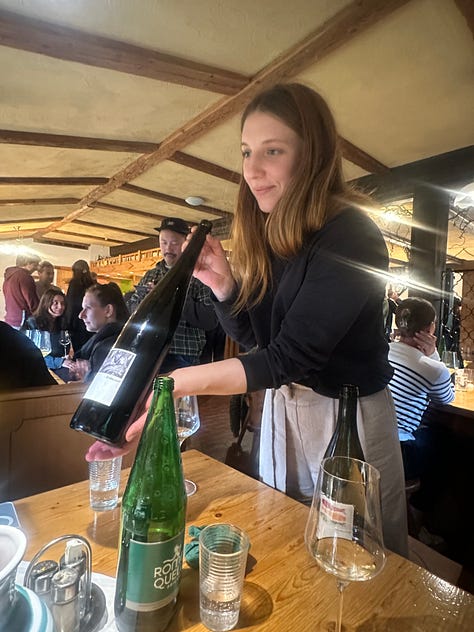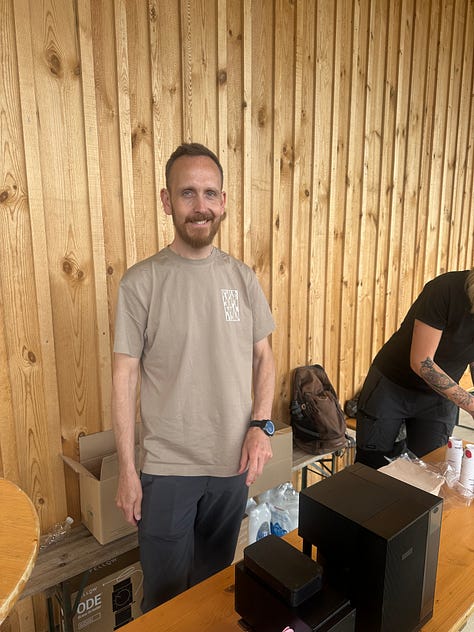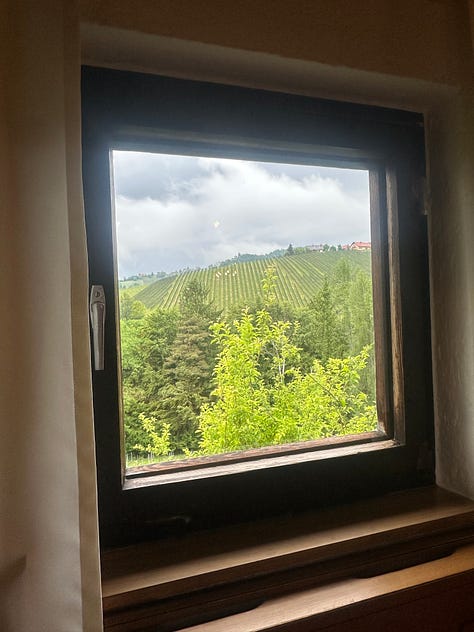What Austria Teaches Us About Oregon
Karakterre is case study in how to build international community (and relevance) through genuine care, culture, and purpose









VIENNA—For the past five days I’ve been tasting my way through Central European natural wines at Karakterre, the world’s leading festival of its type and region, representing a community of winemakers from Austria, Germany, Croatia, and as far east as Bulgaria and Georgia. It’s a spirited, passionate, and fun group, as winemakers often tend to be, and especially the natural winemakers, whose advocacy for minimal intervention within the winemaking process seems to draw a type of individualist and free-spirited type of person that, when you have enough of these people in one room (or wine region), it makes for one hell of a party. Whether you believe you’re a fan of natural wine or not, you are going to have a great time at Karakterre because the people who attend are incredible, including a growing core group of industry fans who come to Austria for this event every year—including me for my second straight year.
Karakterre was started by my friend Marko Kovac, a native of Croatia who grew up when that country was part of Tito’s Yugoslavia. At one point he was a journalist for the BBC, and today produces versions of Karakterre here in Austria, in New York City, and most recently in Verona, an event that kicked off its inaugural showing earlier this year. Marko stays busy, both in the Central European wine world and in Thailand, where he’s part of the extended team of the legendary Calcutta-born Bangkok chef Gaggan Anand, whose restaurant Gaggan was among the most memorable (and indescribable) dining experiences of my life when I visited Bangkok in December.
According to World’s 50 Best, Gaggan is the number one restaurant in Asia and the number nine restaurant in the world. Most would agree that World’s 50 Best is the most important global ranking of gastronomically innovative restaurants in the world—moreso than Michelin because the list is truly global and inclusion does not require payment to Michelin in order to cover the cost of the inspectors (Note—Michelin is an investment that may be smart for Oregon if implemented thoughtfully, inclusively, and at the right time), and certainly more than the James Beard Awards, which unfortunately no one really knows (or cares) about outside of the United States. Don’t get me wrong—the James Beard Awards are huge, but America is really the only country that elevates its own national awards above those that are more global. Having both a national and global point of view is really moves the conversation forward in food and beverage.
That background and backstory is a long way of saying that Marko’s peer group, like that of many of us who work in the culinary world, is broadly international, and that network is exactly why Karakterre is where you’ll meet the many individuals and organizations in the Karakterre orbit: wine importers from London and Paris, great chefs from Rotterdam and Mexico City, elite wine and food editors from New York and Berlin, restaurant wine directors from Dallas and Brooklyn, and the CEO of the most revered glassware company on the planet. I met all of these people in the past four days, and we were not sitting desk-side in a high-rise nor burning a distracted 30 minutes at some Manhattan coffee shop. We were sharing sparkling wines in Styria with the people who made them, eating wild boar tacos on a hilltop in Austria that overlooks a Hungarian village, and having late-night schnitzel at Glacis Beisl, a restaurant in central Vienna famous for well-executed traditional Austrian fare plus a rather eccentric wine list. It’s also something of a clubhouse for Karakterre’s inner circle throughout the entire festival weekend.
Marko and Karakterre are reminders that the most important skillset in creating an internationally relevant event is not a mastery of tenting, nor some type of social media influencer plan—but the desire, passion, and ability to skillfully build and steward a focused global community around a singular idea or region. And once you do that, you will need to find talented people who are badasses at production and clever promotion—and those skillsets require a lot more than a knowledge of tenting and Instagram stories.
In the world of international community building, festivals can be ideal constructs and revenue models because they bring people together in an authentic manner and allow industry to connect in ways that beget more industry. And if envisioned correctly, great events present a strong business case for industry to attend year after year. When that happens, good programming happens—because you’re drawing the right extended community of participants. Good programming is what will drive your ticket sales more than any Zuckerberg shit-click strategy—despite what the shit-click agencies will charge you hundreds or thousands per hour to tell you.
Sadly, in the United States, the tie between community, culture, and events is mostly not understood—and it’s precisely why so many great wine, food, music, art, culture, and design events (and organizations like theater and performing arts groups) right now are struggling—because the regional support they do (but mostly don’t) receive is not tied to the business development they spark, the connections they foster, the culture they steward, the influence they draw for the region, the television producers and editors they attract, the retail and wine buyers they host, the national and global connectivity they generate, and the way all of the aforementioned factors, when combined, fosters a generative ecosystem that perpetually drives engagement, press, business, and visitation for a place—and not just during a festival weekend.
For the most part in the U.S., the success of an event is mostly tied to filling hotel rooms—which is an important metric, but one that is only achieved if you’re able to get all of the aforementioned items correct. In other words, we tend to skip the foreplay.
This is not a criticism of the tourism industry by the way, it’s a way of saying there are more metrics and more industries than just hotels and tourism that benefit from events that deeply attract industry, and this is more broadly understood and practiced in other parts of the world.
I digress, but you get the point.
Back to Karakterre, the festival was born in Vienna, but since 2022 has moved to the Burgenland region, a famous wine and agricultural zone you enter the moment you leave Vienna. It’s so close to the city that everyone in Vienna—your Uber driver, your concierge, the guy who made your morningcappuccino—will proudly tell you that the Austrian capital is closer to vineyards than any major city in Europe. In this regard, Vienna is like Portland, which is the major American city that’s closest to a big wine region. And that’s not the only similarity. Austria’s wine world feels a lot like Oregon’s culturally speaking. Not only do you see some similarity in varietals and techniques, but there is a similar air of individuality among the winemakers and those working in wine—natural wine or otherwise. Austria often gets lumped into the same category as its larger neighbor Germany because of the language similarities, but these countries could not feel more different.
Austria, compared with its larger European peers, makes only a fraction of the wine as France, Germany, or Italy, and twice that of Oregon. In other words, Austria is the underdog, which is probably why it’s so relatable to me as a guy who grew up in Oregon.
And also like Oregon, Austria is beautiful.
In gorgeous Styria, a steep and hilly region framed by the Slovenian Alps to the south, you are often greeted in tasting rooms by a family member of a winemaker—or the winemaker themselves. The landscapes inspire. The hills are so precipitously steep that everyone (sadly) has a story about a tractor accident during the harvest process. As vineyard topography goes, I have never seen anything like it—not even in Italy’s Alto Adige, where vineyards snake up the foothills of the Dolomites.
And these views cannot be captured by photography—at least not my photography.
There’s a similar human vibe in Burgenland, but in that place, the eastern reaches of Austria drop into more of a gentle landscape dotted with old villages and mostly small farms among the vineyards. On car trips, you may look across a river to the country of Slovakia, or take in a vista of Hungary from a hilltop. Everything is jammed together in the best possible way in Central Europe.
The first time I was exposed to Austrian wine was the year 2009 when great Portland culinary teacher Robert Reynolds was hosting guest chefs as a way of keeping his famous Chef Studio cooking school running while Robert was being treated for cancer, a disease that would sadly take his life three years later.
One of these dinners was hosted by the seminal Portland Chef Chris Israel, who had been rightfully credited with the reinvention of Portland restaurants with the seminal Zefiro in Northwest Portland in the 1990s. In fact, up until about 2010 before that restaurant started to fade from mainstream memory, Portland dining was often described in two different epochs: pre-Zefiro and post-Zefiro. It wasn’t that there weren’t other great chefs at the time (Cathy Whims, Greg Higgins, Vitaly Paley, Cory Schreiber and others were busy putting Oregon on the map in a culinary sense), but Chris Israel’s and Bruce Carey’s Zefiro was a restaurant that would not have felt out of place in the West Village or the Marais—or at least that’s what I was told because Zefiro was before my time. Zefiro represented Portland growing up, and it inspired dozens of restaurants that are still open today.
After its closure, Israel moved to New York and found a new life as a designer for Condé Nast, but by the late Aughts had retired to Portland to team up with Kurt Huffman to open Gruner for what I believe was the first of Huffman’s ChefStable restaurant group. While it existed, Gruner was among the best restaurants in Portland, and really the first great restaurant in the neighborhood that wasn’t yet called the West End.
Among Gruner’s greatest legacies was the introduction of Austrian wine to Portland.
That night at Robert’s studio, Chris was joined at the dinner by his young wine director, Dana Frank, and thanks to Dana, that evening was the first time I (and probably the 30 people in that room) had ever tried Austrian wine. What’s more, her list at Gruner during the short six or seven years that restaurant was open was a celebration of interesting wines from Austria and places like it—and in the decade and a half since, Dana has built an entire career making Austrian wines popular in America. This year at Karakterre, I was joined by my good friend/Oregon salt king Ben Jacobsen. Throughout our entire weekend when we’d chat with any Austrian winemaker of note and tell them we were from Portland, the smiles would get bigger and the pours more generous. It’s true that Portland and the Willamette Valley have a greater degree of respect in this part of the world than most American wine regions, but it was only because we knew Dana Frank that we were treated like royalty in Austrian wine country.
Dana’s springtime event The Wild Bunch draws dozens of important and innovative winemakers from Austria and around the world to Portland—and draws the very youthful and enthusiastic crowd that many winemakers fear they’re losing.
They should fear not. The younger Millennials and older Gen Z’ers that are in fact drinking are increasingly looking to natural winemakers and places like Austria (and Oregon) more than traditional spots like Napa and Bordeaux, which honestly can feel a little boring. In a world increasingly shaped by algorithms, right now the best strategy is lean into what makes places special and unique.
And speaking of unique, one fact that I love about Oregon is this.
We produce only one percent of American wine by volume, but produce more than half of the organic and biodynamic wine in America. It’s fair to note that natural wine and organic/biodynamic wine are not exactly the same thing. There are many shades of grey and entire books on this subject written by people with a knowledge far greater than my own rudimentary wine IQ, but the takeaway here is that Oregon likes to do things its own way—and right now this is what we need to celebrate.
I’m leaving for Holland today for one of Randy Miller’s Best Practices trips, and from there I’m heading straight to Austin, Texas on Thursday for Hot Luck, one of my own festivals, where I’ll be meeting up with hundreds of peers who I’ve met and known from over the years and from all over the globe.
The food and beverage world isn’t always an easy place to play, but I can’t think of a more interesting world—and there is nowhere else I’d rather be.




Stay safe and come back with good stories
Well done Michael! Travel well!